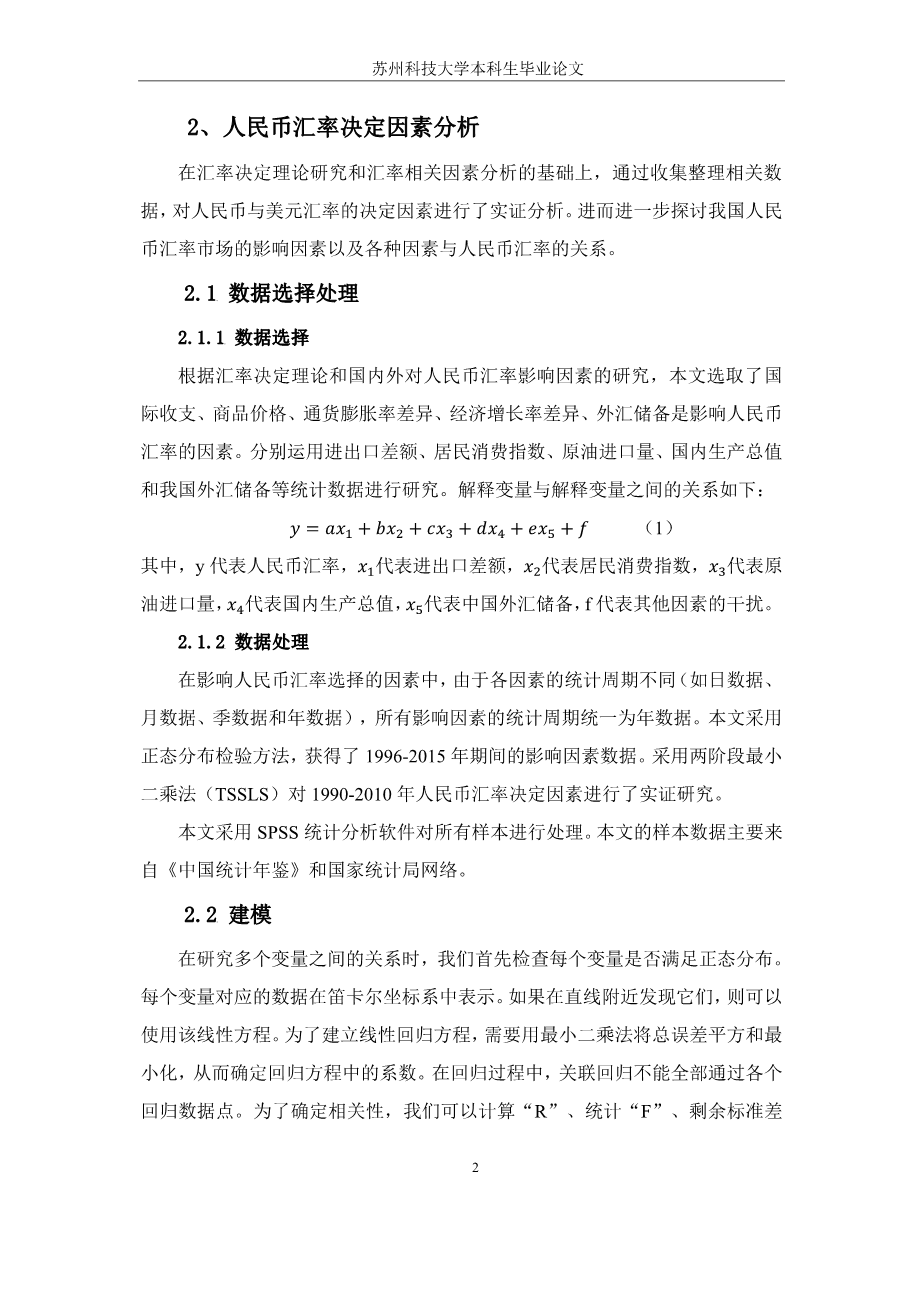附录B 外文原文
Analysis of Influencing Factors of RMB Exchange Rate Trend
Based on Least Square Method
- Introduction
Exchange rate represents the national currency exchange rate which marks the standard of fair distribution of economic transactions among countries. The exchange rate adjustment can change a countrys foreign trade ability and affect the countrys economic development level. Since the reform and opening up, with the development of the global economy and Chinas active participation in the world financial circle, the demand for domestic and foreign market resources has become an important driving force for the growth of Chinas domestic economy. The economy of China and the world has formed an interdependent relationship.
The study of exchange rate determination theory includes two aspects: the decisive factor and the trend of exchange rate change. The exchange rate determines the direction and development of the exchange rate. Exchange rate determinants influence the trend and development of exchange rate. There are many factors influencing the change of the RMB exchange rate, which determines the trend of the RMB exchange rate. Fundamentally, the main factors influencing exchange rate changes include: inflation rate differential, commodity price, economic growth rate differential, foreign exchange reserve, the international balance of payments, etc. Zhang yuxi simply used the method of econometrics analyzing the impact of the RMB exchange rate from gross domestic product (GDP) and consumer price index (CPI)[1]; Shao mingji used EViews software analyzing the general influencing factors of exchange rate and found out the main influencing factors of exchange rate, which led to better prediction of exchange rate and macro-control, so that the RMB could better meet the need of market development and better play its function of resource allocation and adjustment; Taking the change of RMB exchange rate as the explanatory variable, Liao zizhen analyzed the significance of GDP growth, RMB against US interest rate differential, inflation rate, foreign exchange reserve and other factors on the exchange rate by establishing a multivariate linear regression model and concluded that foreign exchange reserve had a significant impact on the fluctuation of RMB exchange rate. Then this paper proposed suggestions on how to maintain exchange rate stability and promote the internationalization of RMB;By analyzing the exchange rate overshooting model, li Yanfeng believed that the main factors influencing the fluctuation of RMB exchange rate were the monetary policy of US dollar interest rate increasing, the expectation of market depreciation, the segmentation of RMB exchange rate market and the RMB crawling peg exchange rate system.
- Analysis on determinants of RMB exchange rate
Based on the research of exchange rate determination theory and the analysis of relevant factors of exchange rate, the empirical analysis of the determinants of exchange rate between RMB and US dollar is carried out by collecting and collating relevant data. Then we can further explore the influencing factors of Chinas RMB exchange rate market and the relationship between various factors and the RMB exchange rate.
2.1. Data selection processing
2.1.1. Data selection.
According to the exchange rate determination theory and the domestic and foreign studies on the influencing factors of RMB exchange rate, this paper selects the international balance of payments, commodity prices, inflation rate differentials(INFL), economic growth rate differentials, foreign exchange reserves as the influencing factors of RMB exchange rate. The statistics of import and export balance, household consumption index, crude oil import volume, gross domestic product and Chinas foreign exchange reserves are respectively used for research. The relationship between explanatory variables and explained variables is constructed as follows:
(1)
In(1), y represents the exchange rate of RMB, represents balance of imports and exports, represents household consumption index, represents crude oil import volume, represents gross domestic product, represents Chinas foreign exchange reserves, frepresents interference from other factors.
2.1.2. Data processing.
Among the factors influencing the selection of RMB exchange rate, because the statistical cycles of each factor are different (such as daily data, monthly data, quarterly data and annual data), the statistical cycles of all influencing factors are unified into annual data. In this paper the normal distribution test is used to obtain the data of influencing factors within the interval from 1996 to 2015. A two-stage least-squares method (TSSLS) is used to conduct an empirical study of the decision factors of RMB exchange rate with the data of 1990-2010.
In this paper, SPSS statistical analysis software is used to process all samples. The sample data of this paper mainly come from China statistical yearbook and national bureau of statistics network.
2.2. Modeling
We first check whether each variable satisfies the normal distribution when we study the relationship between multiple variables. The data corresponding to each variable is depicted in Cartesian coordinate system. This linear equation can be used if they are found in the vicinity of a straight line. In order to establish the linear regression equation we need to use the least square method to minimize the sum of the total error squares, so as to determine the coefficients in the regression equation. The ssociated regression cant all pass through each regression data point in the process of regression. To determine the correlation we can calculate the correlation of the 'R', the statistical 'F', the remaining standard deviati
剩余内容已隐藏,支付完成后下载完整资料


英语译文共 5 页,剩余内容已隐藏,支付完成后下载完整资料
资料编号:[413847],资料为PDF文档或Word文档,PDF文档可免费转换为Word


